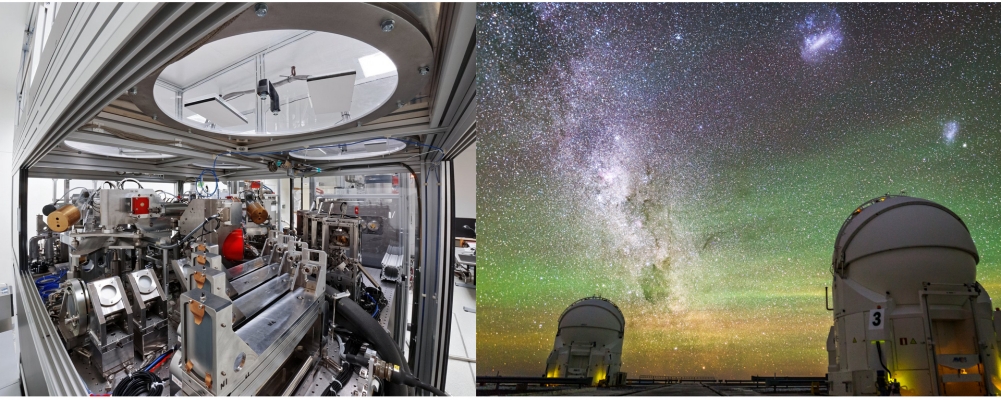GRAVITY for MATISSE (GRA4MAT) Science Verification
The deadline for proposal submission is Monday 24 February 2020, 18:00 CET
The proposals should be submitted using the Phase 1 web interface and selecting GRA4MAT SV proposal cycle. For any questions, please contact us at gra4matsv@eso.org

MATISSE is the mid-infrared 4T beam combiner of the Very Large Telescope Interferometer. The GRAVITY near-infrared combiner has been recently commissioned to be used as a fringe tracker for MATISSE, enlarging the spectral coverage and improving the sensitivity of MATISSE. This observing mode is called "GRA4MAT".
We wish to demonstrate the scientific gain of MATISSE extended spectral coverage during a dedicated Science Verification run. All astronomers are invited to participate in this unique opportunity. 4 nights with the ATs will be devoted to the GRA4MAT Science Verification (SV) in April 2020.
Instrument modes
Limiting fluxes derived from the last commissioning run are:
| spectral mode | lowest L flux (Jy) | lowest M flux (Jy) | ||
|---|---|---|---|---|
| corr. Flux & diff phase | closure phase | corr. Flux & diff phase |
closure phase | |
| LOW (R~35) | 0.2 | 0.5 | 1 | 4 |
| MED (R~500) | 1 | 1.5 | 15 | 10 |
| HIGH (R~1000) | 2 | 3 | not offered | not offered |
| HIGH+ (R~3300) | 20 | 25 | 17 | 25 |
The Limiting magnitude for GRAVITY's Fringe Tracker depends on the atmospheric conditions as follows:
| Occurence probability | 10% | 50% | 85% |
|---|---|---|---|
| Seeing | <0.6" | <1.0" | <1.4" |
| Coherence Time | >5.2 ms | >3.2 ms | >1.6 ms |
| K mag | <8.5 | <7.5 | <6.5 |
- N-band is currently not commissioned in the GRA4MAT mode.
- Chopping is not currently supported, so photometric data are not collected. It means that absolute visibilities cannot be estimated. Only correlated fluxes, differential phases and closure phases can be extracted. In case absolute visibilities in the continuum are required for the data interpretation, one may request, in addition, MATISSE standalone observations (in LOW mode), in a separate observing run.
- Spectral coverage goes as follow: LOW and MED cover the full L and M-bands. HIGH is limited to L-band, and HIGH+ starts in L at 4.02 microns (it covers the Br-alpha hydrogen line) and covers the M-band.
- Proposals can request observations with any of the AT configurations: Small, Medium and Large. However, considering the SV run will be only four nights, it is recommended to request only one or two configurations.
- For the Telescope/AO guide star, the limiting magnitude is set my the condition that NAOMI must be in full AO correction, i.e. Gmag<12.5
Schedule
- 31th January 2020: Call for Proposals
- 24th February 2020: Deadline for proposal submission
- 16th March 2020 : Proposers informed about the outcome
- 8th April 2020: Deadline for Phase 2 Material for SV
- 27th April 2020: GRA4MAT Science Verification observations start
The observations will be conducted in Service Mode by a dedicated team of ESO and MATISSE team astronomers. The MATISSE SV team will be able to assist the successful PI¹s in the preparation and optimisation of the OBs on a best effort basis only. The collected data will be made available to the whole ESO user community.
GTO protected targets
The list of protected targets for the MATISSE Guaranteed Time Observations is available for P105. Observations of targets protected by the MATISSE GTO will not be accepted for SV.
Pipeline
The MATISSE data reduction pipeline was released. Instructions for installing and running the pipeline can be found here:
http://www.eso.org/sci/software/pipelines/matisse/
Note this version is preliminary and has not been fully verified. If you notice unexpected behaviour, please consult the "Bug Reports" section of the page.
WARNING: all (raw) data and calibrations are public immediately after the observations. There is no proprietary period nor earlier data release to the PIs. See the VLT Science Verification Policy and Procedures for more details.
Science Verification Team
- Armin Gabash (ESO)
- Xavier Haubois (ESO)
- Christian Hummel (ESO)
- Walter Jaffe (MATISSE)
- Bruno Lopez (MATISSE)
- Anthony Meilland (MATISSE)
- Antoine Mérand (ESO)
- Anna Pala (ESO)
- Claudia Paladini (ESO)
- Isabelle Percheron (ESO)
- Romain Petrov (MATISSE)
- Thomas Rivinius (ESO)
- Markus Schoeller (ESO)
- Peter Scicluna (ESO)
- Markus Wittkowski (ESO)
- Julien Woillez (ESO)
Citation Policy
Publications based on SV data should quote the following reference papers:
- MATISSE: Lopez, B., et al., An Overview of the MATISSE Instrument - Science, Concept and Current Status, 2014, The Messenger, Vol. 157, pp. 5-12
- GRAVITY: GRAVITY Collaboration, et al., First light for GRAVITY: Phase referencing optical interferometry for the Very Large Telescope Interferometer, A&A 602-94 (2017)
General Information
An integral part of the commissioning of a new instrument at the VLT is the Science Verification phase. SV programmes include a set of typical scientific observations that should verify and demonstrate to the community the capabilities of the new instrument in the operational framework of the VLT Observatory. See the SV Policy and Procedures: http://www.eso.org/sci/activities/vltsv/svdoc.pdf
